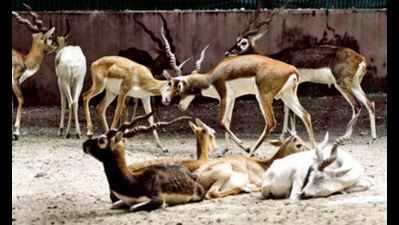- News
- City News
- jaipur News
- Soon, 17 new rescue wards for antelopes in Jodhpur
Trending
This story is from December 15, 2016
Soon, 17 new rescue wards for antelopes in Jodhpur
In a major stride towards bringing down casualty rate of antelopes in Jodhpur district, the state government has sanctioned 17 new wildlife rescue wards in order to provide timely medical aid to the injured chinkaras and blackbucks.

An amount of Rs 42.50 lakh has been sanctioned for these upcoming wards, of which 1.50 lakh would go into construction
JODHPUR: In a major stride towards bringing down casualty rate of antelopes in Jodhpur district, the state government has sanctioned 17 new wildlife rescue wards in order to provide timely medical aid to the injured chinkaras and blackbucks.
All these 17 wards will be built in the existing veterinary hospitals at the 17 locations chosen by the forest department in consultation with the wildlife activists, organizations and villagers.Each ward will be a 15x30 feet enclosure divided into three compartments.
DFO (wildlife) Mahendra Singh Rathore said that an amount of Rs 42.50 lakh has been sanctioned for these upcoming wards, of which 1.50 lakh would go into construction while the rest would be spent on training, transportation of animals, and medicines, etc.
Currently, Jodhpur has four rescue centres at Khejadli, Luni and Phalodi besides the main rescue centre at Jodhpur zoo.
“All these places have been chosen keeping in mind the concentration of chinkaras and blackbucks and are widely spread to cover the entire district evenly,” Rathore said.
Rampal Bhawad of the Bishnoi Tiger Force (BTF) said that this was a long-pending demand of the BTF in order to bring down the death rate of the antelopes in the district, so that the dependency on the four rescue centres could be reduced and the injured antelopes could get treatment at the nearest possible centre.
According to a rough estimate, the rate of survival of the injured chinkaras and blackbucks is not more than 20% at all the four rescue centres put together. With the 17 new centres coming up within next one month, the rate of death is expected to come down considerably. Veterinarian Sharavan Singh Rathore said that there is a massive habitation of chinkaras and blackbucks in the district and the major causes of injury are dog bite and road accidents.
All these 17 wards will be built in the existing veterinary hospitals at the 17 locations chosen by the forest department in consultation with the wildlife activists, organizations and villagers.Each ward will be a 15x30 feet enclosure divided into three compartments.
DFO (wildlife) Mahendra Singh Rathore said that an amount of Rs 42.50 lakh has been sanctioned for these upcoming wards, of which 1.50 lakh would go into construction while the rest would be spent on training, transportation of animals, and medicines, etc.
Currently, Jodhpur has four rescue centres at Khejadli, Luni and Phalodi besides the main rescue centre at Jodhpur zoo.
The 17 new centres will come up at Dhava, Poonia ki Piao, Baori, Bhopalgarh, Bilara, Bala, Sathin, Osian, Chamu, Balesar, Lohawat, Shergarh, Dechu, Ketu, Baap, Aau, and Jamba.
“All these places have been chosen keeping in mind the concentration of chinkaras and blackbucks and are widely spread to cover the entire district evenly,” Rathore said.
Rampal Bhawad of the Bishnoi Tiger Force (BTF) said that this was a long-pending demand of the BTF in order to bring down the death rate of the antelopes in the district, so that the dependency on the four rescue centres could be reduced and the injured antelopes could get treatment at the nearest possible centre.
According to a rough estimate, the rate of survival of the injured chinkaras and blackbucks is not more than 20% at all the four rescue centres put together. With the 17 new centres coming up within next one month, the rate of death is expected to come down considerably. Veterinarian Sharavan Singh Rathore said that there is a massive habitation of chinkaras and blackbucks in the district and the major causes of injury are dog bite and road accidents.
End of Article
FOLLOW US ON SOCIAL MEDIA










